The Grain Mill Grinder Market is estimated to be valued at USD 1080.1 million in 2025 and is projected to reach USD 1693.5 million by 2035, registering a compound annual growth rate (CAGR) of 4.6% over the forecast period.
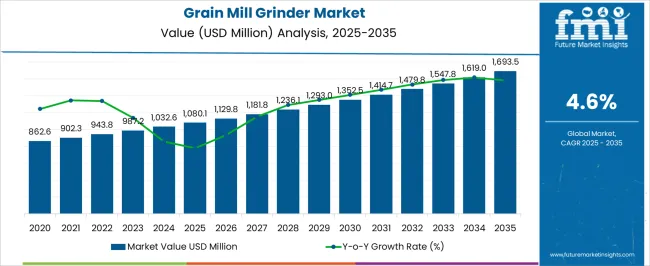
| Metric | Value |
|---|---|
| Grain Mill Grinder Market Estimated Value in (2025 E) | USD 1080.1 million |
| Grain Mill Grinder Market Forecast Value in (2035 F) | USD 1693.5 million |
| Forecast CAGR (2025 to 2035) | 4.6% |
The grain mill grinder market is experiencing steady growth as demand for fresh and nutritionally superior milled products continues to rise across both domestic and commercial settings. Advancements in milling technology, coupled with consumer inclination toward whole grains and minimally processed flours, are driving adoption of modern grinders.
Regulatory emphasis on food quality and hygiene is further encouraging replacement of outdated equipment with more efficient and precise models. Future growth is expected to be fueled by increasing penetration in developing regions, ongoing innovation in materials and mechanisms, and the expansion of organized retail and specialty food segments.
Strategic focus on durability, energy efficiency, and ease of use is paving the path for broader adoption and market maturity, while sustainability considerations are shaping design and sourcing practices to meet evolving consumer and regulatory expectations.
The market is segmented by Type, Application, and Sales Channel and region. By Type, the market is divided into Burr Grain Mill Grinder, Blade Grain Mill Grinder, and Impact Grain Mill Grinder. In terms of Application, the market is classified into Flour Milling, Animal Feed Milling, and Oilseed Milling. Based on Sales Channel, the market is segmented into Offline and Online. Regionally, the market is classified into North America, Latin America, Western Europe, Eastern Europe, Balkan & Baltic Countries, Russia & Belarus, Central Asia, East Asia, South Asia & Pacific, and the Middle East & Africa.
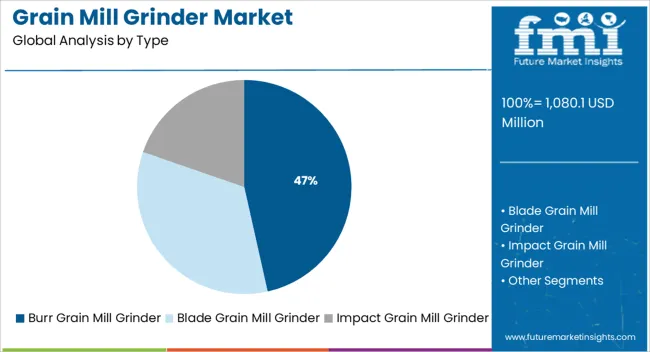
When segmented by type, burr grain mill grinders are expected to hold 46.50% of the total market revenue in 2025, positioning themselves as the leading type segment. This dominance is attributed to the superior grinding consistency and quality offered by burr mechanisms compared to alternatives.
The ability to produce uniform particle sizes with minimal heat generation has enhanced their suitability for preserving the nutritional value and flavor of grains, which has been increasingly demanded by discerning consumers and artisanal producers. Durability and ease of maintenance have also been observed as key factors reinforcing their preference in both household and commercial applications.
The precision and versatility of burr grinders in handling various grain textures and quantities have further solidified their market leadership by delivering reliable performance under diverse operating conditions.
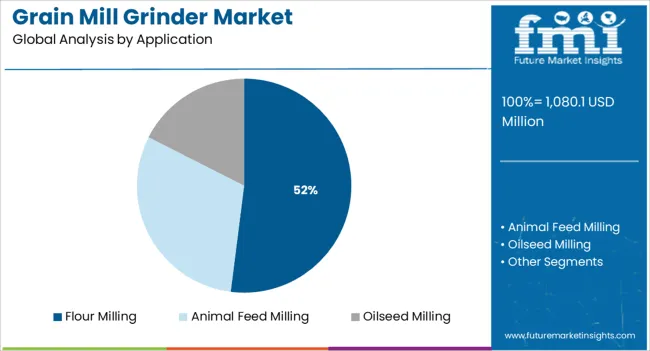
In terms of application, flour milling is projected to account for 52.00% of the market revenue share in 2025, making it the most prominent application segment. This leadership has been supported by the growing popularity of fresh, custom-milled flours among health-conscious consumers and professional bakers alike.
The ability of grain mill grinders to produce fine, consistent flour from a variety of grains has made them indispensable in home kitchens, small bakeries, and specialty food businesses. Evolving dietary preferences toward whole grain and gluten-free options have further fueled demand within this segment.
The integration of more efficient grinding mechanisms tailored for flour production and the rising awareness of the benefits of freshly milled flour over pre-packaged alternatives have reinforced the prominence of this application in driving market revenues.
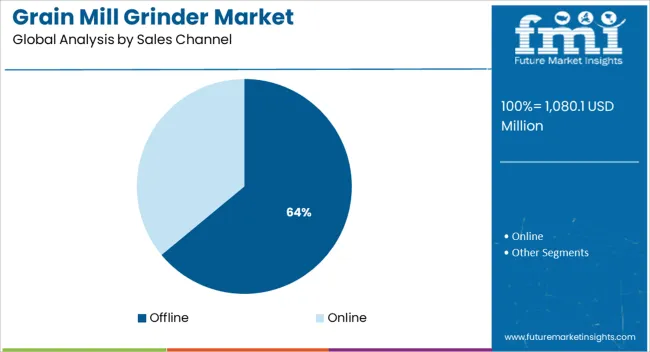
Segmented by sales channel, offline distribution is forecast to capture 64.00% of the market revenue in 2025, establishing itself as the dominant channel. This leading position has been strengthened by consumers’ preference for physically evaluating the quality, build, and performance of grinders before purchase.
The role of specialized kitchenware stores, dealer networks, and direct sales in educating buyers and providing after-sales service has been observed as critical in fostering customer trust and satisfaction. Offline channels have also been instrumental in catering to commercial buyers who require tailored solutions and on-site demonstrations.
The tactile assurance, immediate availability, and ability to consult knowledgeable staff have continued to reinforce the offline segment’s leadership despite the gradual rise of online retail, particularly in regions where consumer confidence in digital platforms is still developing.
According to Future Market Insights, the worldwide grain mill grinder industry grew at 4.3% CAGR during the period of 2020 to 2025 and reached a valuation of USD 1080.1 million at the end of 2025.
However, with rising adoption across several end-use sectors, the overall grain mill grinder demand is projected to increase at a steady CAGR of 4.6% between 2025 and 2035.
Several factors are driving the global market for grain mill grinders. First, the rising health consciousness among consumers is leading to an increased demand for healthy and nutritious food items. This is resulting in a growing preference for freshly ground flour and cereals, which is expected to boost the demand for grain mill grinders.
Second, the increasing disposable incomes of consumers in developing economies are providing them with greater purchasing power, which is fueling the demand for higher-end and premium products. This is expected to drive the market for grain mill grinders as manufacturers focus on introducing more sophisticated and feature-rich products.
Third, the growing popularity of home baking and cooking is also playing a crucial role in driving grain mill grinders' demand as they offer an easy and convenient way to grind fresh flour at home.
A number of influential factors have been identified that are expected to impact the dynamics of the global grain mill grinder industry during the projection period (2025 to 2035). Furthermore, FMI analysts have also analyzed the lucrative opportunities, imminent threats, and restraining elements, that can somehow influence sales of grain mill grinders.
The drivers, restraints, opportunities, and threats (DROTs) identified are as follows:
DRIVERS
RESTRAINTS
OPPORTUNITIES
THREATS
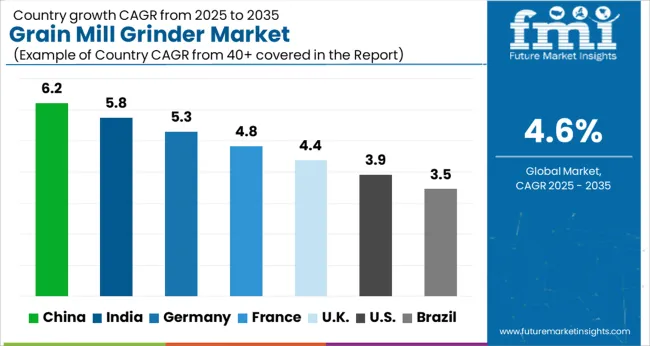
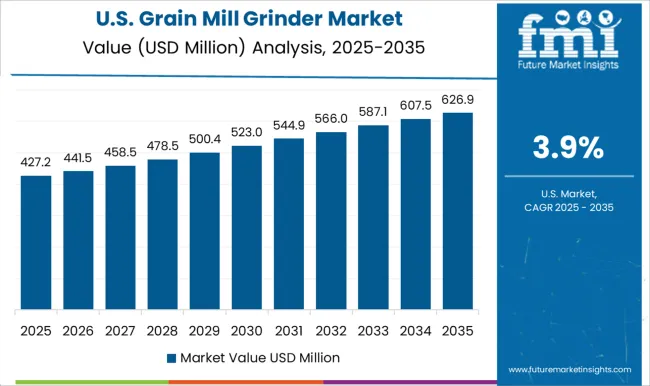
Growing Demand for Organic and Healthy Food Products Boosting the USA Market
According to Future Market Insights, the USA accounts for around 35.2% of the global grain mill grinder industry and it is expected to develop at a rapid pace during the assessment period. The main reason for this is the increasing demand for healthy and organic food along with the growing popularity of freshly milled flour.
More and more people across the USA are becoming health conscious and are looking for ways to improve their diet. They are consuming various types of flours due to their numerous health benefits.
For instance, fresh flour is a good source of energy, fiber, and other nutrients. It keeps the digestive system healthy and helps to reduce the risk of constipation and other digestive disorders. As a result, the demand for grain mill grinders has increased significantly.
Similarly, the rapid growth of the bakery industry coupled with the high adoption of grain milling solutions across this sector is boosting grain mill grinder sales and the trend is likely to continue during the forecast period.
High Adoption of Grain Mill Grinders across Households Making China and India Promising Markets
The market for grain mill grinders in Asia Pacific is expanding at a rapid pace due to the growing demand for flour and other food products made from grains. The region has a large population of people who consume grains as a staple part of their diet.
Grain mill grinders are used to process various types of grains into flour, and these machines are becoming more popular across countries like India and China due to their ability to produce a higher-quality product.
FMI predicts the grain mill grinders demand in India and China to grow at 6.4% and 6.1% CAGRs respectively, making them the most lucrative markets across the Asia Pacific. Rapid growth in population, increasing consumption of flour, and high adoption of grain milling equipment across households are some of the key factors fueling grain mill grinder sales in these markets.
Ability to Produce a More Uniform Flour Making Burr Grain Mill Grinder Popular
Based on type, the burr grain mill grinder segment holds a substantial share of the global market and the trend is likely to continue during the forecast period. This is attributed to the rising end-user preference for burr grain mill grinders due to their ability to produce uniform flour.
A burr grain mill grinder is a machine that grinds wheat, rye, and other grains into flour using two abrasive surfaces. The wheat is ground between two burrs, one of which is stationary while the other rotates. The rotation of the burr grinds the wheat kernels into flour.
The advantage of burr grain mill grinders is that they produce a more uniform flour than other grain mill grinders and that does not overheat the flour, which can destroy some of the nutrients in the wheat kernels.
However, burr grain mill grinders are more expensive and require more maintenance, such as cleaning and sharpening, to keep them in good working condition. As a result, many people are looking for other cost-effective grain mill grinders such as blade grain mill grinders.
Blade grain mill grinders are more affordable than other types of grain mills. They are compact, easy to use, and give users more control over the grind size of grains, which is important for baking and cooking purposes. Thanks to these attractive features, FMI has predicted a steady CAGR for the blade grain grinder segment for the projection period.
Flour Milling Remains the Most Lucrative Application across the Globe
By application, the global market for grain mill grinders is segmented into flour milling, animal feed milling, and oilseed milling. Among these, the flour milling segment holds the largest revenue share of the market and it is expected to grow at a significant pace over the next ten years. This is attributed to the rising usage of grain mill grinders for making flour from various types of grains. Similarly, increasing demand for flour across sectors like bakery, confectionery, households, and food & beverage will positively influence the grain mill grinder sales during the forecast period.
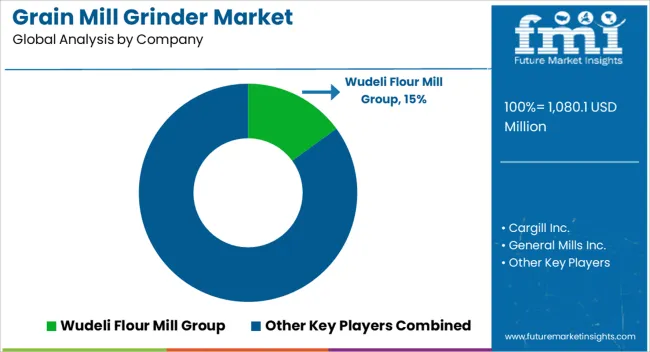
The competitive landscape of the grain mill grinder market is highly fragmented with a large number of players present in it. Some of the key players operating in this market include Cargill Inc., General Mills, Inc., Archer Daniels Midland Company, and Bunge Limited. These players are engaged in intense competition with each other to gain a larger share of this market.
New product launches, mergers, acquisitions, partnerships, and the move toward online sales channels are some of the strategies adopted by key market players to increase their sales and stay relevant in the market. Some recent development by major players are listed below:
| Attribute | Details |
|---|---|
| Estimated Market Size (2025) | USD 1080.1 million |
| Projected Market Size (2035) | USD 1693.5 million |
| Anticipated Growth Rate (2025 to 2035) | 4.6% CAGR |
| Forecast Period | 2025 to 2035 |
| Historical Data Available for | 2020 to 2025 |
| Market Analysis | Value (USD Million) |
| Key Regions Covered | North America; Europe; Asia Pacific; Latin America; Middle East & Africa (MEA); RoW |
| Key Countries Covered | The USA, Canada, Mexico, Germany, The UK, France, Russia, Brazil, Argentina, Japan, Australia, China, India, Indonesia |
| Key Segments Covered | Type, Application, Sales Channel, Region |
| Key Companies Profiled | Cargill Inc.; General Mills Inc.; Archer Daniels Midland Company; Bunge Limited; Pingle Machinery; Wudeli Flour Mill Group; Ardent Mills, LLC; Allied Pinnacle Pty Ltd.; Manildra Milling Pvt. Ltd.; Acarsan |
| Report Coverage | DROT Analysis, Market Forecast, Company Share Analysis, Market Dynamics and Challenges, Competitive Landscape, and Strategic Growth Initiatives |
The global grain mill grinder market is estimated to be valued at USD 1,080.1 million in 2025.
The market size for the grain mill grinder market is projected to reach USD 1,693.5 million by 2035.
The grain mill grinder market is expected to grow at a 4.6% CAGR between 2025 and 2035.
The key product types in grain mill grinder market are burr grain mill grinder, _wheels, _discs, blade grain mill grinder, _horizontal, _vertical, impact grain mill grinder, _hammer mills and _plate mills.
In terms of application, flour milling segment to command 52.0% share in the grain mill grinder market in 2025.






Our Research Products

The "Full Research Suite" delivers actionable market intel, deep dives on markets or technologies, so clients act faster, cut risk, and unlock growth.

The Leaderboard benchmarks and ranks top vendors, classifying them as Established Leaders, Leading Challengers, or Disruptors & Challengers.

Locates where complements amplify value and substitutes erode it, forecasting net impact by horizon

We deliver granular, decision-grade intel: market sizing, 5-year forecasts, pricing, adoption, usage, revenue, and operational KPIs—plus competitor tracking, regulation, and value chains—across 60 countries broadly.

Spot the shifts before they hit your P&L. We track inflection points, adoption curves, pricing moves, and ecosystem plays to show where demand is heading, why it is changing, and what to do next across high-growth markets and disruptive tech

Real-time reads of user behavior. We track shifting priorities, perceptions of today’s and next-gen services, and provider experience, then pace how fast tech moves from trial to adoption, blending buyer, consumer, and channel inputs with social signals (#WhySwitch, #UX).

Partner with our analyst team to build a custom report designed around your business priorities. From analysing market trends to assessing competitors or crafting bespoke datasets, we tailor insights to your needs.
Supplier Intelligence
Discovery & Profiling
Capacity & Footprint
Performance & Risk
Compliance & Governance
Commercial Readiness
Who Supplies Whom
Scorecards & Shortlists
Playbooks & Docs
Category Intelligence
Definition & Scope
Demand & Use Cases
Cost Drivers
Market Structure
Supply Chain Map
Trade & Policy
Operating Norms
Deliverables
Buyer Intelligence
Account Basics
Spend & Scope
Procurement Model
Vendor Requirements
Terms & Policies
Entry Strategy
Pain Points & Triggers
Outputs
Pricing Analysis
Benchmarks
Trends
Should-Cost
Indexation
Landed Cost
Commercial Terms
Deliverables
Brand Analysis
Positioning & Value Prop
Share & Presence
Customer Evidence
Go-to-Market
Digital & Reputation
Compliance & Trust
KPIs & Gaps
Outputs
Full Research Suite comprises of:
Market outlook & trends analysis
Interviews & case studies
Strategic recommendations
Vendor profiles & capabilities analysis
5-year forecasts
8 regions and 60+ country-level data splits
Market segment data splits
12 months of continuous data updates
DELIVERED AS:
PDF EXCEL ONLINE
Grain Hardness Meter Market Size and Share Forecast Outlook 2025 to 2035
Grain Cooling Spear Market Size and Share Forecast Outlook 2025 to 2035
Grain Roller Market Size and Share Forecast Outlook 2025 to 2035
Grain Alcohol Market Size and Share Forecast Outlook 2025 to 2035
Grain-Free Pet Food Market Trends - Growth & Industry Forecast 2024 to 2034
Grain And Seed Cleaning Equipment Market
Migraine Treatment Market Insights by Drug Class, Route of Administration, Distribution Channel, Treatment, and Region through 2035
Migraine Nasal Spray Market Outlook – Trends, Growth & Forecast 2025 to 2035
Feed Grain Market Analysis - Size, Share, and Forecast Outlook 2025 to 2035
Multigrain Premix Market Trends – Healthy Baking & Industry Expansion 2025 to 2035
Horse Grain Feeders Market Size and Share Forecast Outlook 2025 to 2035
Whole Grain & High Fiber Foods Market Growth – Demand, Trends & Forecast 2025–2035
Whole Grain Salty Snacks Market Analysis by Product Type, Product Claim, Source, Distribution Channel and Region Through 2035
Multi-Grain Premixes Market
Acute Migraine Treatment Market Trends – Analysis & Forecast 2024-2034
United Kingdom Whole Grain and High Fiber Foods Market Report – Trends & Forecast 2025–2035
United States Whole Grain and High Fiber Foods Market Report – Trends & Forecast 2025–2035
Commercial Grain Mill Market Size and Share Forecast Outlook 2025 to 2035
Dried Spent Grain Market Trends – Growth & Industry Forecast 2025 to 2035
Europe Whole Grain and High Fiber Foods Market Insights – Size & Forecast 2025–2035

Thank you!
You will receive an email from our Business Development Manager. Please be sure to check your SPAM/JUNK folder too.
Chat With
MaRIA